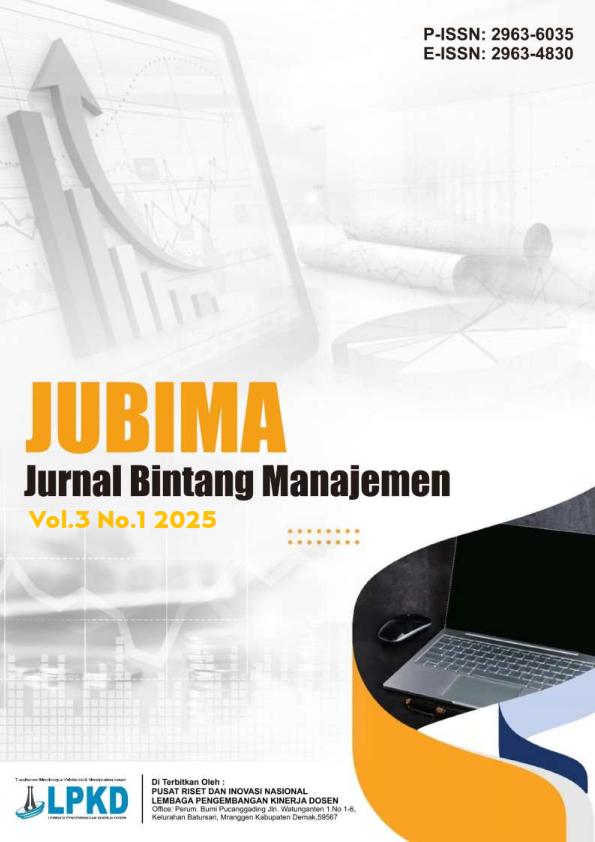Pengaruh Cyberloafing terhadap Kinerja Karyawan melalui Self Control Sebagai Variabel Moderasi pada PT Swadharma Sarana Informatika Surabaya
DOI:
https://doi.org/10.55606/jubima.v3i1.3739Keywords:
Cyberloafing, Employee Performance, Self-ControlAbstract
The purpose of this study was to determine the test results and analysis of the effect of cyberloafing on employee performance through self-control as a moderating variable at PT Swadharma Sarana Informatika Surabaya. The population and sample in this study were 86 active employees at PT Swadharma Sarana Informatika Surabaya, the sampling used was a census. The analysis method used was SPSS with Moderated Regression Analysis (MRA) analysis for testing hypothesis 3 which is a special application of multiple linear regression. The results showed that cyberloafing had a negative and significant effect on employee performance, self-control had a positive and significant effect on employee performance and self-control weakened the relationship between cyberloafing and employee performance.
References
Anandarajan, M., Simmers, C., & Igbaria, M. (2000). An exploratory investigation of the antecedents and impact of internet usage: An individual perspective. Behaviour and Information Technology, 19(1), 69–85. https://doi.org/10.1080/014492900118803
Anderson, C. A., & Dill, K. E. (2000). Video games and aggressive thoughts, feelings, and behavior in the laboratory and in life. Journal of Personality and Social Psychology, 78(4), 772–790. https://doi.org/10.1037/0022-3514.78.4.772
Blanchard, A. L., & Henle, C. A. (2008). Correlates of different forms of cyberloafing: The role of norms and external locus of control. Computers in Human Behavior, 24(3), 1067–1084. https://doi.org/10.1016/j.chb.2007.03.008
Bougie, U. S. (2016). Research methods for business (7th ed.).
Brown, S. P., & Peterson, R. A. (1993). The effect of effort on sales performance and job satisfaction. Journal of Marketing, 57(4), 70–80. https://doi.org/10.1177/002224299305700406
Detert, J. R., & Burris, V. F. (2007). Leadership behavior and employee voice: Is the door really open? Academy of Management Journal, 50(4), 869–884. https://doi.org/10.5465/amj.2007.26279146
Duckworth, A. L., Taxer, J. L., Eskreis-Winkler, L., Galla, B. M., & Gross, J. J. (2019). Self-control and academic achievement. Annual Review of Psychology, 70, 319–347. https://doi.org/10.1146/annurev-psych-010418-102032
Hopp, W. J., & Xu, K. (2005). A comparison of simulation and optimization approaches for designing flexible manufacturing systems. Management Science, 51(3), 488–507. https://doi.org/10.1287/mnsc.1040.0356
Igbaria, M., & Tan, M. (1997). The consequences of information technology acceptance on individual performance: A review and implications for future research. Information Systems Research, 8(3), 195–203. https://doi.org/10.1287/isre.8.3.195
Lee, Y., & Lee, J. (2000). The roles of work values in the relationship between job characteristics and job satisfaction. Journal of Vocational Behavior, 57(3), 324–335. https://doi.org/10.1006/jvbe.1999.1759
Lim, V. K. G. (2002). The IT way of loafing on the job. Journal of Organizational Behavior, 23(5), 675–694.
Lim, V. K. G. (2005). The moderating effect of neutralization technique on organizational justice and cyberloafing. 9th Pacific Asia Conference on Information Systems: I.T. and Value Creation, PACIS 2005, 207–219.
Lim, V. K. G., & Teo, T. S. H. (2005). Prevalence, perceived seriousness, justification and regulation of cyberloafing in Singapore: An exploratory study. Information and Management, 42(8), 1081–1093. https://doi.org/10.1016/j.im.2004.12.002
Nelson, D. L., & Quick, J. C. (2006). Organizational behavior: Foundations, realities, and challenges (5th ed.). Thomson South-Western.
Yang, Y., Lee, P. K. C., & Cheng, T. C. E. (2016). Continuous improvement competence, employee creativity, and new service development performance. International Journal of Production Economics, 182, 374–384. https://doi.org/10.1016/j.ijpe.2016.08.017








